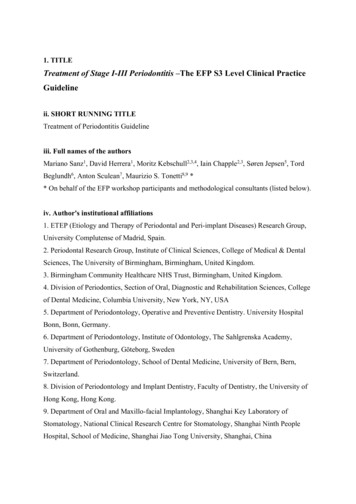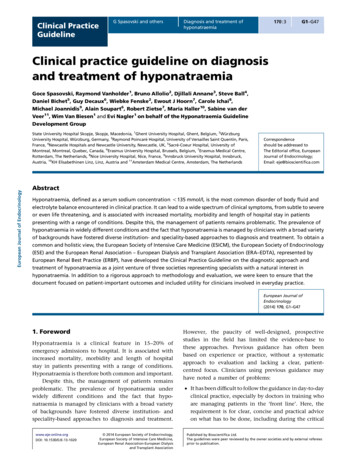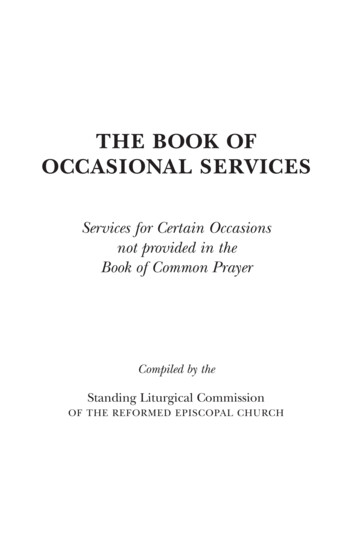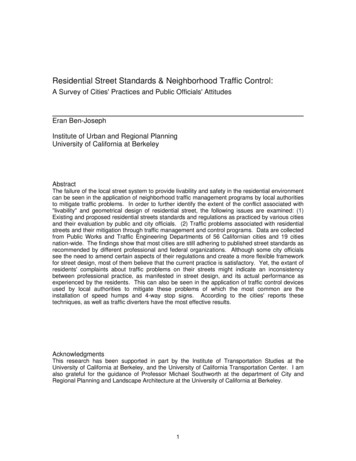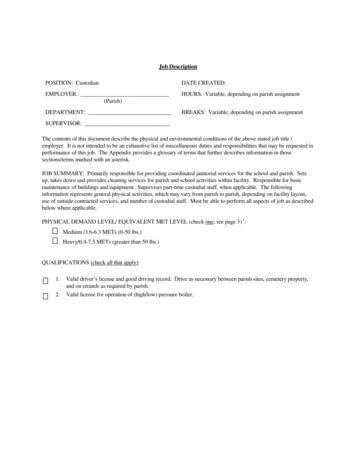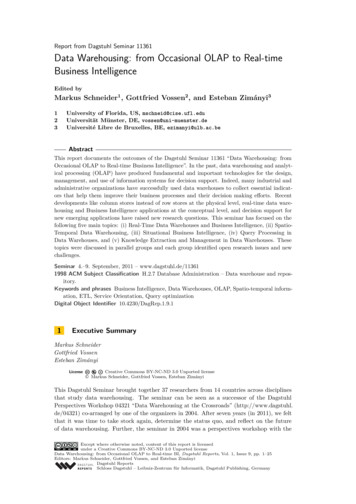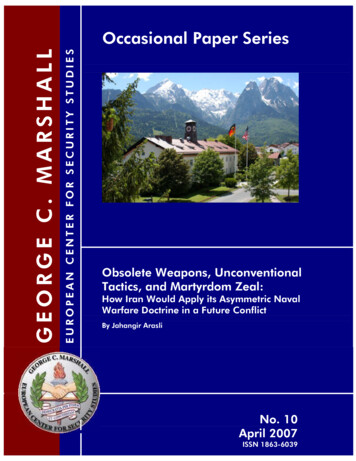
Transcription
EUROPEAN CENTER FOR SECURITY STUDIESGEORGE C. MARSHALLOccasional Paper SeriesObsolete Weapons, UnconventionalTactics, and Martyrdom Zeal:How Iran Would Apply its Asymmetric NavalWarfare Doctrine in a Future ConflictBy Jahangir ArasliNo. 10April 2007ISSN 1863-6039
Form ApprovedOMB No. 0704-0188Report Documentation PagePublic reporting burden for the collection of information is estimated to average 1 hour per response, including the time for reviewing instructions, searching existing data sources, gathering andmaintaining the data needed, and completing and reviewing the collection of information. Send comments regarding this burden estimate or any other aspect of this collection of information,including suggestions for reducing this burden, to Washington Headquarters Services, Directorate for Information Operations and Reports, 1215 Jefferson Davis Highway, Suite 1204, ArlingtonVA 22202-4302. Respondents should be aware that notwithstanding any other provision of law, no person shall be subject to a penalty for failing to comply with a collection of information if itdoes not display a currently valid OMB control number.1. REPORT DATE3. DATES COVERED2. REPORT TYPEAPR 200700-00-2007 to 00-00-20074. TITLE AND SUBTITLE5a. CONTRACT NUMBERObsolete Weapons, Unconventional Tactics, and Martyrdom Zeal. HowIran Would Apply its Asymmetric Naval Warfare Doctrine in a FutureConflict6. AUTHOR(S)5b. GRANT NUMBER5c. PROGRAM ELEMENT NUMBER5d. PROJECT NUMBER5e. TASK NUMBER5f. WORK UNIT NUMBER7. PERFORMING ORGANIZATION NAME(S) AND ADDRESS(ES)George C. Marshall Center for Security Studies,ECMC-CL-O-MCP,Unit24502,APO,AE,090539. SPONSORING/MONITORING AGENCY NAME(S) AND ADDRESS(ES)8. PERFORMING ORGANIZATIONREPORT NUMBER10. SPONSOR/MONITOR’S ACRONYM(S)11. SPONSOR/MONITOR’S REPORTNUMBER(S)12. DISTRIBUTION/AVAILABILITY STATEMENTApproved for public release; distribution unlimited13. SUPPLEMENTARY NOTES14. ABSTRACT15. SUBJECT TERMS16. SECURITY CLASSIFICATION OF:a. REPORTb. ABSTRACTc. THIS PAGEunclassifiedunclassifiedunclassified17. LIMITATION OFABSTRACT18. NUMBEROF PAGESSame asReport (SAR)5119a. NAME OFRESPONSIBLE PERSONStandard Form 298 (Rev. 8-98)Prescribed by ANSI Std Z39-18
The George C. Marshall European Center for Security StudiesThe George C. Marshall European Center for Security Studies is a leading transatlantic defense educational and security studies institution. It is bilaterally supported by the U.S. and German governments and dedicated to the creation of amore stable security environment by advancing democratic defense institutionsand relationships; promoting active, peaceful engagement; and enhancingenduring partnerships among the nations of North America, Europe, and Eurasia.The Marshall Center Occasional Paper SeriesThe Marshall Center Occasional Paper Series seeks to further the legacy of theCenter’s namesake, General George C. Marshall, by disseminating scholarlyessays that contribute to his ideal of ensuring that Europe and Eurasia are democratic, free, undivided, and at peace. Papers selected for this series are meantto identify, discuss, and influence current defense related security issues. TheMarshall Center Occasional Paper Series focus is on comparative and interdisciplinary topics, including international security and democratic defense management, civil-military relations, strategy formulation, terrorism studies, defenseplanning, arms control, peacekeeping, crisis management, regional and cooperative security. The Marshall Center Occasional Papers are written by MarshallCenter faculty and staff, Marshall Center alumni, or by individual, invited contributors, and are disseminated online and in a paper version.The views expressed in this publication are those of the author(s) and do notnecessarily reflect the official policy or position of the George C. Marshall European Center for Security Studies, the U.S. Department of Defense, the GermanMinistry of Defense, or the U.S. and German Governments. The general editor ofthis series is the director of the George C. Marshall European Center for SecurityStudies. This report is approved for public release; distribution is unlimited.We invite comments and ask that you send them to:DirectorGeorge C. Marshall CenterECMC-CL-RPGernackerstraße 282467 Garmisch-PartenkirchenGermanyISSN 1863-6039No. 10, April 2007
Obsolete Weapons, UnconventionalTactics, and Martyrdom ZealHow Iran Would Apply itsAsymmetric Naval Warfare Doctrinein a Future Conflict By Jahangir Arasli Editorial Date: December 2006 This article was written as part of a research project, which was led and funded by the George C. MarshallEuropean Center for Security Studies in Garmisch-Partenkirchen.Jahangir Arasli is a civilian advisor on International Issues to the Minister of Defense of the Republic ofAzerbaijan. He holds a Master’s degree from Moscow State University (1983), and is a graduate from the Institute of Countries of Asia and Africa (Arabic Branch).He is also a graduate of the George C. Marshall Center for European Security Studies (Garmisch-Partenkirchen,Germany, 1998), the NATO Defense College (Rome, Italy 2001), the Cranfield University, Royal College ofMilitary Sciences (Shrivenham, United Kingdom, 2004), the Geneva Centre for Security Policy (Geneva, Switzerland 2005 – 2006); and participated in several international courses in Germany, Sweden, and Bulgaria.He has published numerous books and articles in the different magazines and newspapers, most recently: “Whois Who in the World War Four: Terrorists, Insurgents, Separatists, Extremists, Radicals, Mercenaries, Sectariansand Godfathers from A to Z” (2005).
TABLE OF CONTENTSExecutive SummaryGlossaryIntroductionPart 1: Strategies1.11.21.31.4Notion of Asymmetric WarfareIranian Asymmetric ResponseCore Element of MartyrdomIranian Military DualismPart 2: 22.132.142.152.16RootsIran – Iraq War (1): Death of Iranian Imperial NavyIran – Iraq War (2): Birth of Pasdaran NavyIran – Iraq War (3): Guerrilla on WaterIran – Iraq War (4): The First Round with US NavyIran – Iraq War (5): Iran’s Lessons LearnedRebuilding and ReshapingArmed SpeedboatsNaval Special Warfare ForcesUndersea Warfare AssetsCoastal Missile ForcesMine Warfare AssetsOther Unconventional MeansNavy in the Iran’s Political WarfareNavy in the Iran’s Psychological WarfareBracing for D-Day
Part 3: ns: Center of GravityHormuz: ChokepointGulf: Tanker WarUS Navy: High-visibility TargetMines, Mines, Mines A Navy for [the] Shiite CauseEast Med: The Second FrontCaspian: The Third FrontThe Rest of the WorldPostscript: Asymmetry vs. Counter-asymmetryConclusionAttachments:1:List of Quotations of Iranian Leaders and Senior Military Commanders on Deterrence,Asymmetric Warfare, Suicide and Naval Operations (2002 – 2006)2:Iran Regular Navy’s Order of Battle3:Iran Paramilitary Navy’s Order of Battle4:Excepts from Interview of Iran’s Navy CommanderList of Sources:1.Books2.Papers, Reports, Essays &Articles3.Magazines4.Think Tanks, Databases, Online Strategy & Military Resources5.Iranian Pro-Government Pages6.Iranian Anti-Government Iranian Pages7.Forums & Blogs
-6EXECUTIVE SUMMARYThis research paper addresses different (e.g. historical, ideological, operational, tactical, technical)aspects related to the unique asymmetric naval warfare doctrine of the Islamic Republic of Iran(IRI) and its naval forces. It is based on the assumption that the ruling IRI regime is, so far, undeterred and fully determined to achieve its final goal to get weapons of mass destruction, thus settingthe precondition for further dangerous developments which may eventually lead toward directconfrontation with the USA, and perhaps some other state. Research argues that in any kind of amilitary-type scenario, the naval power of the IRI would play a crucial role in the overall asymmetric response by the Iranians. To support this thesis, the research, particularly reviews andanalyzes:-The essence of, and philosophy behind, the Iranian asymmetric warfare strategy (including its part relevant to naval domain), its historical roots and evolution (how the IslamicRevolution, Iran-Iraq war and other events have influenced the strategic visions and operational concepts).-The issue of a martyrdom culture, preached by the IRI regime, and its possible role asforce multiplier in asymmetric warfare.-Specificity of the dual-way [conventional and unconventional capabilities] military organization of the IRI, with emphasis on the unconventional, semi-terrorist nature of theIslamic Revolutionary Guards Corps.-Current Iranian naval capabilities, with the emphasis on its unconventional nature,structure, way of training and tactics.-Possible scenarios of use of the Iranian naval power in the Gulf and Caspian theatres incase of hypothetical military conflict, with the emphasis on the threat to the world energy sector, posed by a potential blockade of the Hormuz Strait, disruption of shippinglines and attacks against oil and gas infrastructure offshore and onshore.-Potential projection of the Iranian asymmetric naval power beyond the Gulf region,particularly through proxy terrorist outfits like HAMAS or Hezbollah.The paper also addresses the issue of insufficiencies and shortcomings in the US and Western navalpostures in regard to the necessity of mitigating and countering naval threats and challenges of anasymmetric nature, which are resulting from the long-term engagement in the global war on terror.The main idea of the research paper makes the case that, in the event of any potential contingency,Iran has the capabilities, determination and incentives to fully and asymmetrically respond inorder to generate far-reaching negative consequences for the international community, primarily inthe world energy domain.This analysis is based solely on open sources. All views expressed are solely those of the author;the research has been conducted in his personal capacity, and is not related to any official position.
-7GLOSSARY4GWacArteshASMASWAWBassijFourth Generation WarfareAircraftRegular Armed Forces of IranAir-to-Surface MissileAnti-Submarine WarfareAsymmetric WarfareIRI Mobilization Resistance Force(volunteers, part of the IRGC)BGBrigadier GeneralbpdBarrels per DayC2Command & ControlC4ISRCommand, Control, Communications, Computers, Intelligence, Surveillance, ReconnaissanceCICCommander-in-ChiefCIWSClose-In WeaponsCOGCenter of GravityCOMINT Communications IntelligenceECMElectronic CountermeasuresEttelaat Intelligence Branch of the IRIMinistry of Intelligence and SecurityEWElectronic WarfareFOCFlag of ConvenienceFPBFast Patrol Boat (i.e. missile craft)GWOT Global War on TerrorismhelHelicopterHQHeadquartersIEDImprovised Explosive DeviceIINImperial Iranian NavyIRIIslamic Republic of IranIRIAFIslamic Republic of Iran Air ForcesIRINIRI Islamic Republic of Iran’s NavyIRGCIRI Islamic Revolutionary GuardsCorps (a.k.a. Pasdaran)IRGCN IslamicRevolutionaryGuardsCorps’ NavyLNGLiquefied Natural GasMANMahmood Ahmadi-Nejad, the IRIPresidentMANPADS Man-portable Air Defense SystemsMCMMine CountermeasuresMFVMotor Fishing VesselMGMajor GeneralMOISIRI Ministry of Intelligence andSecurityMVMerchant VesselNSANon-State ActorNSWNaval Special WarfareORBATOrder of BattleOTHOver-the-HorizonPasdaranIslamic Revolutionary GuardsCorps of IranPDRKPeople’s Democratic Republic ofKorea (a.k.a. North Korea)PRCPeople’s Republic of ChinaPSIProliferation Security InitiativePSYOPSPsychological OperationsRADMRear AdmiralSAVAMA Intelligence Service of the IRIMinistry of Intelligence and SecuritySDVSubmersible Delivery VehicleSLOCShipping Lanes of CommunicationsSOFSpecial Operations k ForceTECHINT Technical IntelligenceUAVUnmanned Aerial VehiclesUCAVUnmannedCombatAerialVehicleUSNUnited States NavyUSSUnited States Navy ShipVEVAKIntelligence Service of the IRIIslamic Revolutionary GuardsCorpsWMDWeapons of Mass Destruction
-9” [The] Navy is Iran’s most important strategic asset.”Jane’s Sentinel Security Assessment, 2006”I think it would be problematic for any navy to face a combination of mines, small boats, antiship cruise missiles, torpedoes, coastal artillery, and Silk-worms This is a credible threat.”Joseph Tenaglia, Chief Executive Officer, Tactical Defense Concepts, a maritime security companyINTRODUCTIONThe bell is not ringing yet. However, the clock is already ticking. Hidden behind the 9/11 attack,Iraq, Afghanistan, other fronts of the global war on terror, the Transatlantic rift, rising China, areviving Russia, climate change and scores of other international agendas, the Iranian nuclear geniesuddenly rose from the shadows. The issue is about to develop into a major crisis.After years of being engaged in entangled negotiations with the EU-3 and the IAEA, all cheatings,hoaxes, back-and-forth tactics, bargaining, missed deadlines, issued threats altered by ‘concessions’and ‘goodwill’ gestures, finally the Islamic Republic of Iran (IRI) has dramatically upped the ante,shifting towards more aggressive behavior, saber-rattling and open defiance in its standoff with theWest over the controversial Iranian nuclear program. The reason for such change is found in the setof Iranian perceptions, which have been shaped by the regional and worldwide developments since2001. The ruling politico-military elite of IRI believe:1. In the strategic paralysis of the USA; Americans are seen as being embattled in Iraq andto a lesser extend in Afghanistan; and that their military capabilities are overstretched by--and near the breaking point---the global war on terror (GWOT); the administration isrestrained domestically, especially after November 06 mid-term elections.2. That the Western ‘coalition’ is fragile and dissenting; the endless offers to negotiate withIran are an indication of weakness; there will be no, if any, really harmful sanctions imposed by the UN Security Council’ against Iran.3. That Western public opinion, easy manipulated by media, will oppose any firm stand(e.g. a military option) against Iran.4. The removal from power of Iran’s bitter foes (Saddam’s regime in Iraq and Talibanregime in Afghanistan), which effectively counterbalanced the IRI in the region, providesIran with the opportunity to decisively change the status quo.5. The war in Lebanon resulted in a ‘strategic divine victory’ 1 of the Iranian proxy Shiitemovement over Israel, providing Tehran an opportunity to intercept the ‘Liberation of Jerusalem’ agenda (i.e. to redefine the whole Palestinian cause and the Arab-Israeli conflict).Perceptions fuel ambitions. These developments and factors are viewed in Tehran as a uniquehistorical chance. Having been driven by a combination of ‘ancient’ Persian and ‘modern’ panIslamic expansionism, Iran is clearly intent [upon] reviving [itself] as a regional super-power, 2 and12‘Hezbollah Chief Touts a Divine Victory’, by Hussein Dakroub, AP, September 22, 2006.‘Iran and Iraq: The Threat from the Northern Gulf’, by Anthony H. Cordesman, p. 28. See also attachment 1with quotes of the Iranian leaders and senior military commanders on this issue.
- 10 even establish itself as a central force in the entire Islamic world 3 . The major question in this regardis how and in which way it intends to proceed towards these goals. As for today, it seems that the IRI(and its regional associates, like Syria and some non-state actors) are ready to increasingly challenge the USA and its Western allies anywhere they can, trying to eject [the US] from the Gulf, Iraqand the Middle East even before the desired nuclear deterrence force emerges to fully shield Iranfrom the anticipated American military strike. The IRI has emerged as a key spoiler in Iraq, fuelling ade-facto sectarian civil war there and torpedoing all efforts of the Iraqi government and the coalitionto restore order and stabilize the country. It supports HAMAS and Hezbollah paramilitary entitiesfighting Israel. It is vocally threatening to destroy the Jewish state, attempting to put Lebanon undercontrol of its proxy movement, and effectively forging the anti-American alliance with radicalregimes in Syria, North Korea, Venezuela, Cuba and some empowered non-state actors, aimed tochallenge Washington’s influence in the region and elsewhere. And foremost, Iran continues to pushits nuclear program, including uranium enrichment cycle, at a network of dispersed, disguised,deeply buried and heavily protected facilities, while simultaneously trying to develop WMD deliverymeans (e.g. the Shahab long-range missiles family).These are the parameters of the emerging crisis. What might follow at the end will possibly be anightmare beyond imagination. The all-out armed conflict (or a series of linked and overlappingconflicts) in the broad area between the Eastern Mediterranean and the Central Asia, reshaping of theregional map, further escalation of tensions between the West and the Islamic world, beginning ofcivil war within Islam itself, skyrocketing hydrocarbons prices, worldwide economic recession, andplenty of other repercussions on the regional and global levels. By all of this, Tehran, under thecurrent regime, definitely poses an overt and growing security threat, which goes far beyond theGulf region itself.Yet, for the time being, Iran seems to be determined to achieve its final goal, is not deterred so far,ready to accept a high degree of all related risks, and even pay a price (better to say, its part of[the] price). As it was put by Maj. Gen. Mohsen Rezaii, the Secretary General of the IRI StateExpediency Council, former Commander-in-Chief of the Islamic Revolutionary Guards Corps andone of the influential figures behind the scene in Iran: ‘We have reached a very important stage andwe need to pay a price for making Iran powerful’ 4 . It appears, the likelihood of the worst-casescenario and readiness to possible preemptive military solutions, eventually taken by the USA, is anintegral part of the regime’s strategy. In its turn, that implies, in case of attack or any other kind ofovert military pressure upon Iran, it very likely would respond with all available means to force the‘aggressor’ to pay a high price too and change its course. Given the huge gap between two potentialadversaries, the ways of retaliation from the Iranian side definitely would be asymmetric.And at this point let us move from the ‘grand picture’ down to advanced case study, focused on howIran might apply its naval power in asymmetric ways in any possible future conflict. We will comeback to geopolitics again in the conclusion of this research paper.34As was made clear by Maj. Gen. Yahya Rahim Safavi, a Commander-in-Chief of the Islamic RevolutionaryGuards Corps of Iran, ‘The Islamic world will soon become a major world superpower Khomeini and Khamenei are the leaders of the Muslim world in their fight against the American and Zionist imperialism ’. See alsoAttachment 1 with quotes of the Iranian leaders and senior military commanders on this issue.IRNA official news agency, March 25, 2006.
- 11 PART ONE: STRATEGIES1.1 Notion of Asymmetric WarfareThere is no universal or commonly agreed definition of asymmetric warfare (AW). However, thegeneric notion of it is a militarily-organized violence between two (or more) disparate adversarieswho are ‘mismatched’ in their strength, capabilities, potentialities, psycho [psychology?], strategic logic and goals, through which a weaker party applies all its efforts and means against theweaknesses of a stronger one 5 . The ability to identify, address and effectively target key vulnerabilities of a stronger [party] gives the weaker [party] a sufficient chance to successfully stand against amuch more powerful, better organized, and equipped enemy. Another crucial element of the AW is ause of unconventional methods 6 , falling away from the traditional (i.e. state-like) approach tomaking a war. Finally, AW is waged in a constantly changing, asynchronous, innovative, unpredictable mode.Through a combination of all of the mentioned patterns, not only is the weaker side (be it a rathersmall state or even a non-state actor) able to counter the overwhelming military superiority of theadversary (be it a big power or even a superpower), but also to influence its public opinion, media,and political landscape. The primary target of the side, applying the AW, is to defeat the adversary’swill to continue. By smart and well-calculated use of asymmetric methods and tools it is capable,despite the adversary’s superiority or supremacy on the military front, to lever the situation on the‘home front’ to such extent, that the will to fight erodes, disengagement by any price is sought, andstrategic defeat eventually comes true.1.2 Iranian Asymmetric ResponseThe Islamic Republic of Iran seems to be one of the countries of the world, truly ‘addicted’ to AW asa universal panacea to defend itself against its perceived enemies. To verify this, it is enough tomonitor statements, speeches and declarations made by different high representatives of the Iranianpolitico-military elite in the past three years, as well as ideological propaganda products delivered byit’s media, all this in the context of a widening stand-off with the West over the nuclear issue. Whatis much more important, the notion of AW has become deeply embedded into the IRI nationalsecurity strategy, diplomacy and military doctrine. Moreover, it is being practiced regularly andincreasingly by the entire military system of Iran.The Iranian concept of asymmetric response is a unique amalgamation of elements of conventionalwarfare, special operations, insurgency tactics and terrorism. It is not defined officially and ishardly to be found in any document (at least publicly known). Rather it represents a systemic set ofreligious thoughts, strategic visions, political considerations, which are practically translated into themilitary forces structure, operational doctrines 7 and tactical procedures. It is based on their ownpainful, unique, and invaluable experience of the protracted, eight year long Iran – Iraq war (1980 –1988), which decisively formed the mindset of at least two generations of both the Iranian elite and[Iranian] society. Furthermore, it encapsulates lessons learned from all recent military conflicts,567‘Asymmetric Warfare: An Indispensable Tool of Terrorism and Insurgency’, by Jahangir Arasli, CombatingTerrorism Working Group – NATO-PFP Consortium, Zurich, Switzerland, September 2005 tp://www.sandersresearch.com/index.php.‘The Strategic Implications of the Iraqi Insurgency IED Campaign’, a Staff Report, Defense & Foreign Affairs:Strategic Policy’, October 2006 issue, p. 10.
- 12 ranging from performance of the modern Western nation-states armed forces (Americans in the GulfI, Gulf II and Afghanistan, Israelis in Lebanon) 8 down to modus operandi of non-state actors visà-vis greater powers in the same conflicts (e.g. insurgency and terrorist operations).The elaboration and practical implementation of the Iranian AW doctrine was accelerated in the firsthalf of 2003, when Tehran, anxiously watched the rapid and massive American military buildup inthe region, followed by the swift advance on Baghdad during the operation Iraqi Freedom, whichclearly indicated to the IRI military that it didn’t have much chance withstanding the US militaryhyper-power in conventional war. As early as in February 2003 Rear Admiral (RADM) Ali Shamkhani, then the IRI Minister of Defense 9 , made it clear that Iran needed to develop an ‘effectivedeterrence by all means’ 10 . After being endorsed by the IRI supreme leader ayatollah Ali Khamenei,this statement has been translated into official guidance.Since that time and until now, huge intellectual, financial, organizational and technical efforts havebeen invested into achieving this end. As the IRI politicomilitary system is not transparent, few details on this pointBox 1: Individuals and Institutions inare known. However, it is still possible to identify someCharge for Devising the AW Conceptindividuals and institutions engaged in this process. It was- Dr. Hasan Abbasi, Director of theadvocated, promoted, devised and coordinated by severalCenter for Doctrinal Studies of Securityfirebrand strategists with a background from the IranianAcross Frontiers and a professor atIRGC Imam Hussein UniversityIslamic Revolutionary Guards Corps (IRGC, a.k.a.- Brig. General Hossein Salami, DirectorPasdaran), as well as several think tanks, also related to theof Operations, IRGC Joint Chiefs StaffIRGC domain (see Box 1) 11 .- Brig. General Mohammad-Ali ‘Aziz’Jaafari, Head of the IRGC Center ofStrategy- Center for Doctrinal Studies ofSecurity Across Frontiers (Markaz-ebarresiha-ye doktrinyal-e amniyat bedunmarz)- IRGC Center of Strategy (a.k.a. theCenter of Strategic Studies)- Strategic Studies Center of theIranian Navy (NDAJA)The asymmetric warfare (dubbed as ‘unbalanced warfare’in Iranian discourse) is interpreted by the IRI strategists as away to deter, deny, mitigate or negate the use ofoverwhelming military force even by a much morepowerful foe (which in fact implies the USA). The essenceof AW was worded in a simple and explicit way in August2005 by the IRGC Brig. General Mohammad-Ali ‘Aziz”Jaafari: ‘As the likely enemy is far more advanced technologically than we are, we have been using what is calledasymmetric warfare methods, our forces are now well prepared for it’. Its principles and parameters in Iranian interpretation appear as follows.891011‘Iran Exercise to Refine Combat Doctrine Tested in Lebanon’, World Tribune, August 18, 2006.Currently is a Head of the IRI Supreme Military Planning Council, since June 2005.The Military Balance 2006, pp. 174 – 175.BG Salami is regarded as a ‘father of asymmetric warfare doctrine’ (Iran Focus, March 31, 2006); he was incharge for clandestine operations in Iraq in 2003; was appointed as Vice-Chairman, the IRGC Joint Chiefs ofStaff in November 2005. Commander of the IRGC Air Force (e.g. missile force) since January 2006 (Iran Focus,March 31, 2006); BG Jaafari was one of Iran’s primary military strategists at the time being; in September 2005was appointed to position of a Head of Internal Security Directorate of the Supreme National Security Council ofIran. The Center for Doctrinal Studies of Security Across Frontiers is alternately depicted by different oppositionsources as an IRGC intelligence unit or a department within the IRI Foreign Ministry (Hamshahri daily, December 4, 2002). The existence of a shadowy NDAJA war center was revealed in 2006 by defectors from the IRGC,who provided the Iranian contingency plan for blocking the Hormuz Strait (‘Iran Readies Plan to Close Strait ofHormuz’, by Kenneth R. Timmerman, NewsMax.com, March 1, 2006; ‘Iran Builds a Secret Underground Complex as Nuclear Tensions Rise’, by Philip Sherwell, The Sunday Telegraph, March 12, 2006).
- 13 In Peacetime:-Deter military attack; contain any hostile behavior by all means available (hard power,soft power, deception).-Maintain high combat readiness of its military forces, prepared for a continued, highintensity stand against an enemy’s much more sizeable, hi-tech, military force.-Develop and rely upon indigenous, [self-] sufficient defense industry capabilities (selfsustainment) 12 .-Train to survive, prepare to react to—and under—a surprise attack, fast-changing situational developments, operational degradation, high pressure and partial loss of its owncommand and control (C2) capacities.In Wartime:1213141516-Decentralize military forces (‘dispersed warfare’) to mitigate enemy’s airpower, firepower, intelligence capabilities, battlefield informational dominance and control [of the]electro-magnetic spectrum 13 .-Incorporate unconventional tactics, assets and tools (e.g. terrorism) 14 into all responsescenarios.-Act aggressively, be agile and innovative, and the use of the element of surprise as coreelements of war on the strategic, operational, and tactical levels.-Intimidate enemy to accept (impose upon) [Iranian war-] scenarios.-Concentrate decisive capabilities (i.e. make a ‘main effort’) when it is needed to addressstrategic weak points of the enemy (a center of gravity, or COG), which are not necessarily of a military nature, or directly linked to an attacking side (i.e. could be a third country).-Conduct offensive retaliatory attacks against areas regarded by the enemy as safe andremote from the war zone (a sort of ‘pay a price’ deep strike) 15 .-Use allied and proxy forces abroad to multiply harmful effect.-Wage intensive political, information and psychological warfare, indivisible from themilitary efforts and targeting enemy’s moral and political will.-Emphasize and exploit the human factor, primarily the religious zeal and martyrdom (i.e.suicide) effort 16 .‘(Iran pays special attention to) the production of equipment related to asymmetric warfare’, as was stated byMG Mostafa Mohammad-Najjar, the IRI Minister of Defense & Logistics on the Parliament testimony (IranFocus, August 24, 2006).‘Iran's military plans for invasion by U.S’, by Iason Athanasiadis, The Washington Times, May 31, 2006.Particularly, Dr. Hassan Abbasi in his interview with Iran's Fars News Agency propagated haras-e moghaddas(sacred terror) against the USA and Israel. See also his personal web-log (http://drabbbasi.persianblog.com).‘We’ll not [allow?] the enemy inside our borders’, stated by the IRGC BG Zolnur (Aftab-e-Yazd daily, January23, 2006).‘Human forces can decide the fate of war. We saw it in Lebanon’, stated by the BG Ashtiani, Deputy Commander-in-Chief, regular Armed Forces of the IRI (Iran Focus, August 17, 2006).
- 14 This last point brings us to perhaps the most crucial point, which makes
Part 3: Scenarios 3.1 Hydrocarbons: Center of Gravity 3.2 Hormuz: Chokepoint 3.3 Gulf: Tanker War 3.4 US Navy: High-visibility Target 3.5 Mines, Mines, Mines 3.6 A Navy for [the] Shiite Cause 3.7 East Med: The Second Front 3.8 Caspian: The Third Front 3.9 The Rest of the World 3.10 Postscript: Asymmetry vs. Counter-asymmetry Conclusion Attachments: 1: List of Quotations of Iranian Leaders .



